Keep the kittens' nest at 28-30°C. A 50 cm by 50 cm cardboard box is a good choice. Up to 14 days – until the moment when the eyes begin to open, the box is closed. After that, the lid is not needed, but you should not carry the babies into the bright light at once.
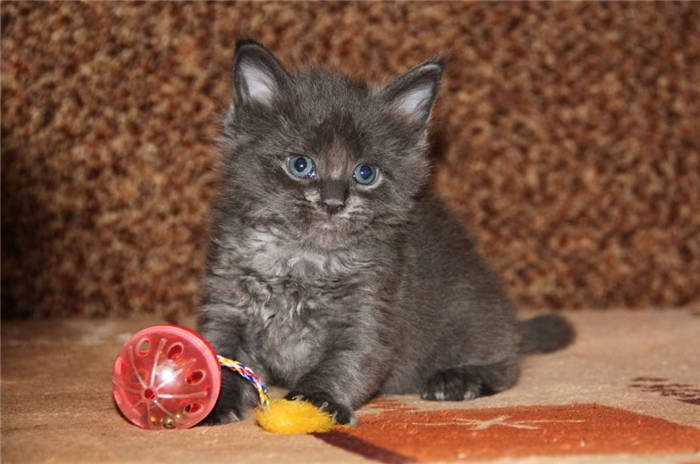
- Cat's milk
- Cat milk substitute
- Selecting the diet of a one-month-old kitten
- Prepackaged foods
- What and how to feed a kitten
- Hygiene and Massage
- How to feed a small kitten: Features and rules
- What things will be needed
- Steps of the procedure
- How to tell if a kitten is full
- How often you should feed
- How to care for two-month old kittens
- Care at 3 months and older
- What natural products can be fed to kittens
- Recipes for Preparing Meals
- What newborn kittens should not be fed
- Health Care
- Treatment against ectoparasites
- Dehelminthization
- When are vaccinations and passports available?
- Decision on neutering, spaying and their timing
- Parenting methods
- Tray training
- Training to the scratching post
- How you can punish a misbehaving pet
- Is it possible to train a cat?
- Care after birth
- With what and how to feed the kitten
- 😼How to feed a small kitten without a mom cat
Cat's milk
Probably the most difficult and at the same time justified way is to find a kitten a nurse. Cat milk has a unique composition, it is full of fats and immunoglobulins, so it is ideal.
The process of communication between the baby and the nursing cat is not as simple as it may seem at first glance.
It is necessary for the cat to accept the kitten, its smell. To do this, you can first pet the nursing cat's native kittens, and then the baby she will feed. If the cat does not reject it, then later difficulties should not arise.
Cat milk substitute
The substitute can be presented in liquid or powder form. The first has a much shorter shelf life.
The composition of this product is as close as possible to natural cat milk and necessarily contains components for the growth and development of the kitten:
For example, Royal Canin's Babycat Milk for kittens from birth to two months of age is similar in composition to cat milk and contains highly digestible proteins and fatty acids. Babycat Milk is adapted to the kitten's digestive system: it has no starch, but it has prebiotics.
Docosahexaenoic acid in its composition contributes to the proper development and functioning of the nervous system, it is also found in natural cat milk.
Selecting the diet of a one-month-old kitten
In order to choose the right diet for a 1-month-old kitten, you need to know what he can be fed and how often to do it. There is an ongoing debate among cat people about whether natural food or ready-to-eat cat food is better. To solve this problem, it is necessary to proceed from what the future cat needs in order for it to grow up healthy, beautiful and strong. Manufacturers of dry food produce products designed for the specific age of the pet and its body requirements. Proponents of natural food are also right: all the useful substances can be obtained from natural food. In order not to break the bank, you have to make a choice in favor of one or the other type of food – you can't mix them.
It's quite possible that you won't be able to choose the right food at once, even ready-made feeds differ from each other. If you mix different brands of food, you can get problems with oversaturation of the body with different elements. As a result, serious digestive disorders will soon arise.
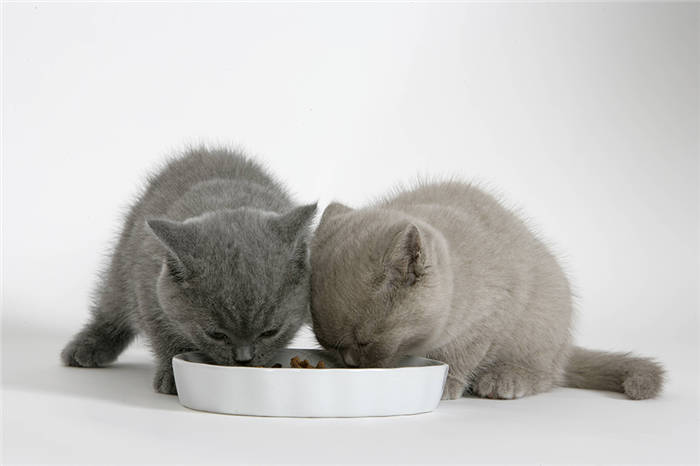
If you take the development of the cat seriously and responsibly, the main rule will be only quality food, and what type it will be, the owner will decide.
Prepackaged foods
Various brands of ready-to-eat cat food are vocal in their praise of their products. The main thing here is not to get lost in the glaring advertising. Let's stipulate that we consider only premium and super-premium cat food.
If you need to feed a 1-month-old kitten, then turn to brands such as:
The manufacturer has already bothered beforehand, has done all the calculations and offers a ready-to-eat food. Experts do not doubt the quality of food from Royal Canin with the prefix "super". The variety of flavors will be perceived by the baby on a hurray.
Feed Acana for kittens is represented by three flavors, which can be alternated. This product does not contain dye, which eliminates the possibility of digestive problems.
Almo Nature is also suitable for one-month-old kittens and consists mainly of quality chicken meat and non-allergenic rice.
When choosing a ready-made food, you need to consider that it should be designed specifically for this age.
What and how to feed a kitten
Kittens are best fed a special mixture. This is not a complete food, but a kind of substitute for cat's milk: it has all the necessary ingredients for the harmonious development of the new body.
Important: Do not feed newborn kittens cow's or goat's milk. It is not suitable for their nutrition.
To feed kittens, do not use pipettes or spoons. You'll only hurt them this way, as the formula could accidentally get into their upper airways. Better yet, buy bottles or nipples with an elongated, thin end that resembles a cat's nipple.
Over time, the hole in the end of the bottle will enlarge from constant use. If it gets too big, you may want to replace the nipple with a different one.
You can also use a syringe, but check the piston: if it is too tight, the mixture can shoot down your throat.
The mixture itself should be diluted according to the instructions on the package. Watch its temperature: it should be neither too hot nor too cold.
Warm the mixture in a water bath. You can check its temperature by putting a drop on your wrist. In no case do not heat it in the microwave: it may not heat evenly, and kittens will get a burn of the mucous membranes as a result.

Before diluting the powder, sterilize the bottles. You can use a baby sterilizer, sterilization tablets, or regular boiling water. This is necessary so that the kitten does not pick up any disease through the nipple.
While feeding, it is better to hold the kitten at an angle of about 45 degrees. Usually he stops sucking the pacifier when he is full. The amount of formula you need should be based on the age and weight of the baby. Don't rush him: let him eat at his own pace. If the milk got into the nose, quickly pump it out with a syringe without a needle or an eyedropper. It is very important to keep the feeding frequency:
Hygiene and Massage
One of the most common problems found in newborn kittens is constipation. If they are cared for by their mother, she makes sure that they do not occur. Without a cat, babies have an increased risk of stool problems.
To keep babies' gastrointestinal tracts working well, massage their bellies and areas under their tails after feeding, using a linen or flannel cloth. Massage until each baby goes to the bathroom.
For the first 5 days The feces will be liquid and clear – this is normal, then they will become thicker and more formed. At first, kittens will go to the bathroom up to 4 times a day, but then that number will be reduced to 2.

After the babies go to the bathroom, wipe their crotches with absorbent cotton, imitating licking movements. After all, the mother cat always licks them after they go to the bathroom. Clean up the excrement right away.
Since their urinary system is also not yet formed, they can only go to the toilet after a massage. After each meal, kittens should defecate.
Once a day, wipe the coats of kittens with a wet cotton pad or tissue. Pay special attention to the ears and nose, as this is where mucus accumulates. Do not touch the eyes until they open. If this does not happen after the third week, then Contact a veterinary clinic.. You may need surgical procedure.
How to feed a small kitten: Features and rules
There are certain rules and nuances of feeding a kitten. This applies to both the mode of feeding and the procedures after it.
What things will be needed
To feed a kitten, you will have to buy some items. More convenient for you and better for the animal will be a bottle with a special nipple: such a thing is sold in a pet store. It has an anatomically correct shape and resembles a cat's nipple.
You can feed newborn kittens without a cat either from an eyedropper or from a syringe without a needle. But this option is not desirable, because during feeding air can get into the esophagus or milk into the airways, and the animal will choke or regurgitate. It is very important to wash and sterilize the items after each feeding.
Steps of the procedure
When everything you need is collected and sterilized, dilute the mixture according to the instructions and heat it up. It is not recommended to do this in a microwave – the mixture may not warm up evenly – it is better to warm it in a water bath.
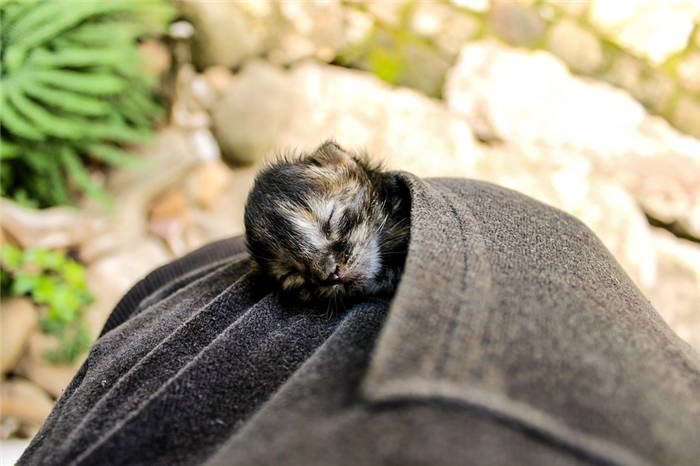
Check the pet's body temperature. If the paws are cold, the kitten is frozen, which means the food will be much less digestible. The baby needs to be kept warm at all times. For this purpose, an electric heating pad wrapped in a towel or a hot water bottle is placed in its box or house.
When you make sure that the kitten is warm, you can proceed directly to the feeding process. To do this, lay a towel on your lap, gently lay the kitten on its stomach and lift its head slightly – this is the position in which kittens feed at their mother's side. The first time you should wet the nipple with milk, so that the kitten will smell food and begin to eat.
How to tell if a kitten is full
Both conditions – underfeeding and overfeeding – are extremely undesirable and even dangerous for a baby. If he does not get enough food, he will not put on weight well and look lethargic. Overfeeding is indicated by liquid stools of yellow, green and gray hues. You can visually tell if a kitten is full by holding out your finger. If the animal starts sucking, it is not full.
How often you should feed
It is imperative that you follow the regime and monitor the portions of the formula. For the first two weeks, you will have to feed the kitten every 2 hours, even at night. Then the intervals are gradually reduced. After five weeks, a kitten can easily go 3-4 hours without food, and one feeding is enough at night.
At 6 weeks of age, kittens eat on their own: they need to be fed up to 5 times a day and only during the daytime. Kittens grow very fast, so the feeding period will not seem very long.
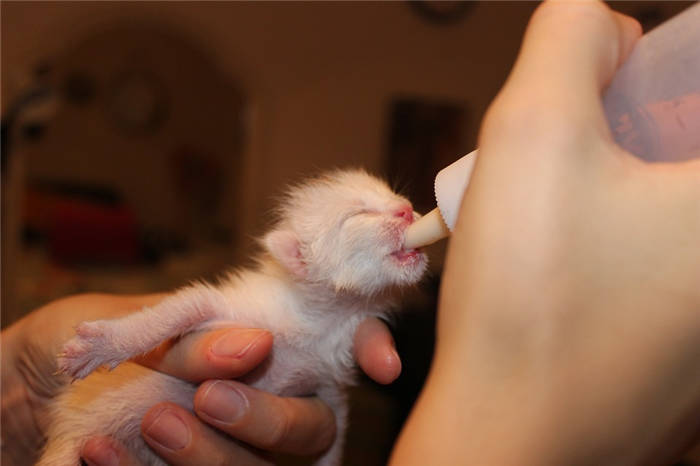
How to care for two-month old kittens
Nutrition. From the second month onwards, the grown-up pet is transferred to a more extended menu. It includes lean meat (beef, turkey, chicken), saltwater fish, sour milk products, vegetables, cereal porridge. Kitten should not be offered river fish, bones, fatty whole milk, potatoes and pasta. Also excluded are any salty, smoked and spicy foods.
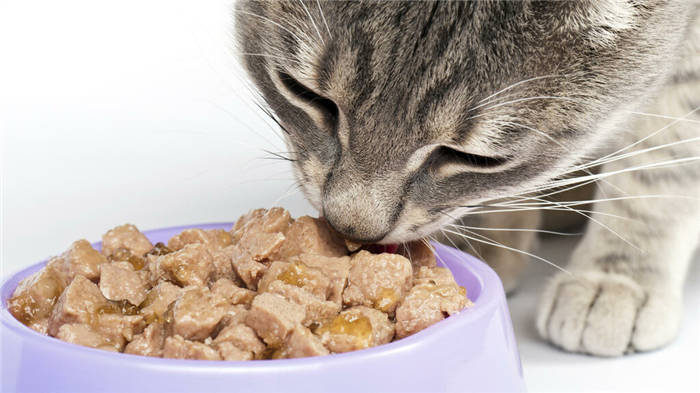
If you choose a ready-made food, it should be marked "for kittens. The frequency of feeding in this period is 5-6 times a day. A two-month-old kitten adds significantly in weight and the mark on the scales reaches 680-900 grams.
Toilet. The litter box is placed in a permanent place. At this age, the kitty is still poorly oriented and she has not developed the habit of going to the toilet in a certain place. Therefore, the task of the owner, who takes care of the kitten, is to help him get used to it. To do this, the pet is manually placed in the litter box. To attract attention, you can use special sprays, which are sprayed directly on the filler.
Hygiene. Procedures for the care of a kitten at 2 months of age remain the same. This cleaning of the ear pads with cotton disks, washing the eyes with boiled water, brushing the hair with special brushes. From two months of age kittens can be bathed. Kittens should be bathed not more often than once every 4-5 weeks.
Vaccinations. Immunization begins when the kitten is 2 months old. Vaccination helps to protect the still weak body against distemper, viral, rhinotracheitis, kalitsivirosis, rabies. Some polyvalent vaccines contain a component against chlamydia. Prior to that, the pet must be treated for parasites and worms.
Chipping. At 2 months of age a young cat may be chipped, although veterinarians believe that it may be done earlier, since the insertion of a microchip under the skin does not affect the health and well-being of the pet. The tiny microchip contains complete information about the cat: name, date of birth, address and other important data.
Care at 3 months and older
Nutrition. The diet of an adult fluffy at this period is very diverse: meat, fish, milk, cottage cheese, egg yolks, porridges, vegetables, cereals (except corn). The food can be offered in bite-sized pieces. But do not put the entire daily ration of food in the bowl at once. The pet has not learned to control its appetite, so it may eat too much. The norm of one feeding is 200 grams per 1 kg of weight of the animal. At 3 months, the kitten eats 400 grams of food per day, and at 4 months – 600 grams.
Hygiene. Kitten care includes the usual complex of hygiene procedures, which is supplemented by brushing teeth. By four months of age, all of the cat's teeth are erupting, so the prevention of dental problems in domestic recluse is mandatory. Teeth are brushed with small brushes and paste with a pleasant smell.
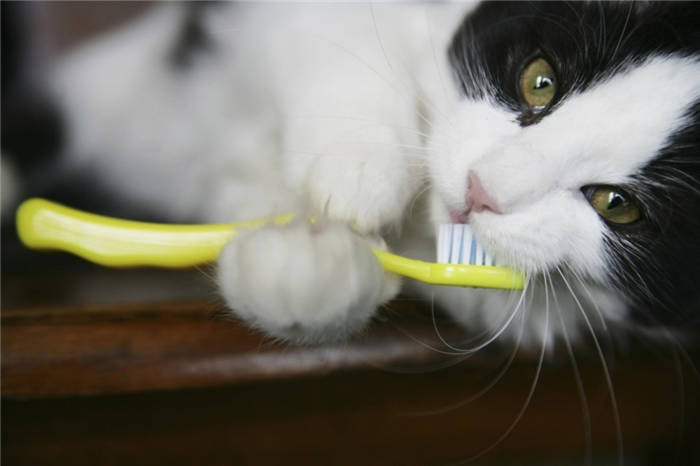
Vaccinations. At 3 months of age, the cat is vaccinated for the second time. Revaccination includes the same preparations that were used a month ago. The next vaccination is scheduled after one year. After the procedure, the well-being of the pet should be closely monitored. If apathy or restlessness, fever, sneezing, swelling in the injection area or other suspicious symptoms occur, you should contact the veterinary clinic.
The owner's excitement about caring for the kitten passes quickly. But if a pet is surrounded by care and attention, many problems bypass it. Kitty grows and develops according to its age and enters adulthood healthy and cheerful.
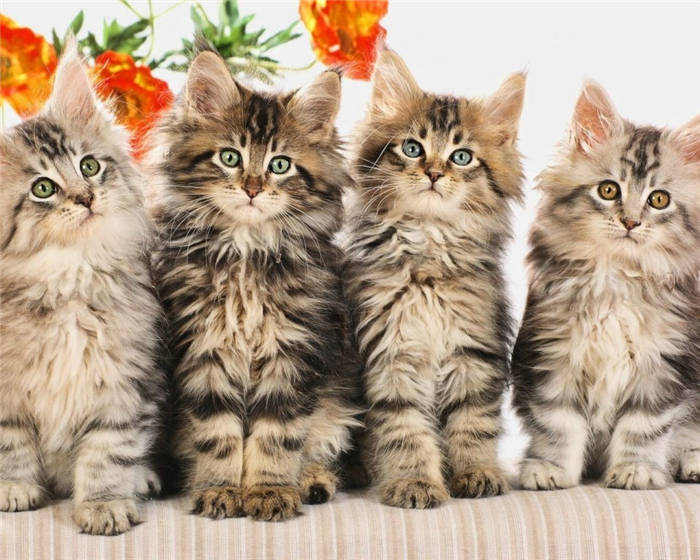
What natural products can be fed to kittens
But there are situations in which you have to take care of a newborn kitten. And this is not an easy task. The hardest part is Properly feeding a kitten. The slightest inattention to the quality of food and the process of feeding can lead to poor health, the development of serious illness and even death of the pet.
For kittens under two weeks of age, the most suitable natural foods are congee, goat's milk and sweetened condensed milk. The first portion should be very small, in order to trace the reaction of the body to the new product.
Corn oil, raw egg and bone meal can also be added to the mixture.
If the baby has grown and the question of how to feed a one-month-old kitten has arisen, then the case is simpler here: chewed cottage cheese, boiled chicken yolk, porridge in meat or milk broth and boiled vegetables.
Recipes for Preparing Meals
A few tried-and-true recipes for kittens during the newborn period:
For 5 parts 20% condensed milk, take 1 part water, 1 tsp bone meal and 1 liter milk. All ingredients are mixed until homogeneous, the liquid is strained and cooled to 36-38 ° C.
For a glass of milk take 2 yolks, 1.tsp. vegetable oil, if desired, a drop of vitamins.
Half a glass of fat milk, egg yolk, 20 ml of glucose 5%, a drop of vitamins.
Strain the mixture and sell within a day. Store the composition in the refrigerator, before taking it warm up to 37 ° C.
All ingredients are taken on the basis of 1 kg of kitten's weight, it is necessary to calculate everything correctly.
You need to take 50 g of fat milk, 15 g of whole milk powder, 3 g of dry yeast, 1 egg, 50 g of whipped protein, 1 g of vegetable oil, 4 g of glucose. Stir the mixture and warm it up to 37-38°C.
Requires 25 g of cow's milk, 5 g of whole milk powder, 2 g of glucose, 1 g of vitamin supplements.
You need to take a teaspoon each of bone meal and milk, 5 tsp of 20% condensed milk and mix everything.
What newborn kittens should not be fed
If you listen to expert advice, ignoring common sense, it does not take long to get into trouble. There are a few "nots" in the diet of newborn kittens, in addition to a strict feeding schedule, dosage and rules for food intake.
- Do not use cow's milk in its pure form; this threatens severe indigestion and possible death.
- No cream, even diluted with water.
- You should not rush and stick your baby with sausage or minced meat.
- When the baby is a little older, also do not rush and feed him raw freshwater fish, otherwise he can be attacked by worms.
Health Care
A house cat is not immune to being infected with parasites and viruses. For this reason, it must be regularly treated against a variety of pests and vaccinated.
Treatment against ectoparasites
Preparations against fleas, ticks and other ectoparasites are used in periods of their increased activity, before mating and vaccination. The method and frequency of application depend on the type of product chosen.
Dehelminthization
Treatment against worms is carried out every quarter or every six months. Deviation from the schedule is possible only in the case of direct infection or vaccination, participation in exhibitions, travel abroad, as well as in the case of surgical intervention.
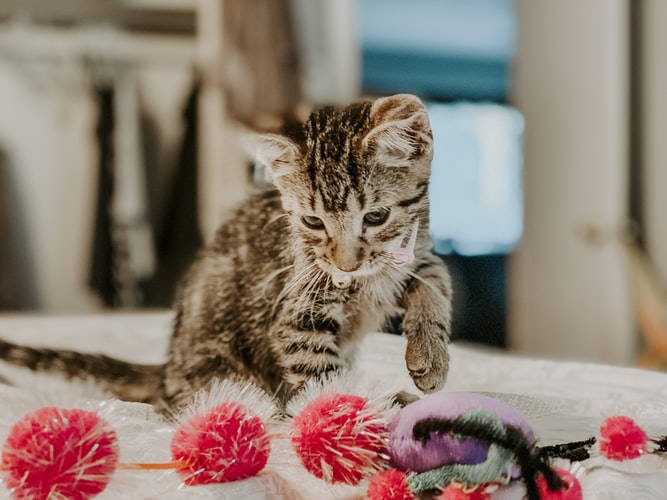
When are vaccinations and passports available?
The first vaccination is given at 2-2.5 months of age, i.e. after weaning. All data about the administered drugs are entered into the veterinary passport, so this document is made after the first treatment.
Decision on neutering, spaying and their timing
The ideal age for surgery is 7-8 months. It is recommended that the cat be spayed before the first heat, as this reduces the likelihood of developing cancer in the future to 0.5%.
Parenting methods
It is better not to delay with the education. A mature pet will listen to you with much less enthusiasm than an unsophisticated baby.
Tray training
On average it takes 2-4 weeks to become litter box trained. As well as your persistence, you should consider the accessibility of the litter box and the privacy of the area. Constantly open litter box door may negate all your efforts, because cats do not tolerate violation of privacy at such intimate moments.
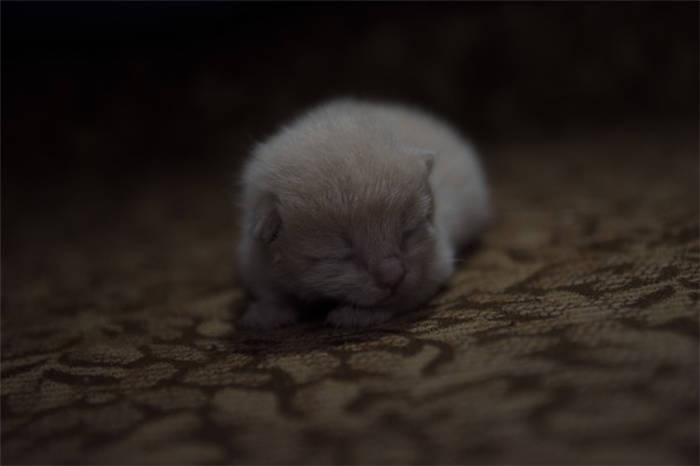
Training to the scratching post
Use liquid catnip and other products that attract cats' attention with their scent. Prevent the spoiling of foreign objects, so that the pet understands that everything except the scratching post is forbidden.
How you can punish a misbehaving pet
As punishment, use prohibition commands uttered in a stern and accusing tone. Accompany them with a spray can or newspaper slamming on the floor near the offender.
Remember, hand-holding and loud shouting are forbidden. Such methods of education may lead to serious mental problems.
Is it possible to train a cat?
Here it all depends on the particular animal. Most cats can be trained to fetch. They love to hunt and often bring their owner balls and mice, engaging in a cooperative game.
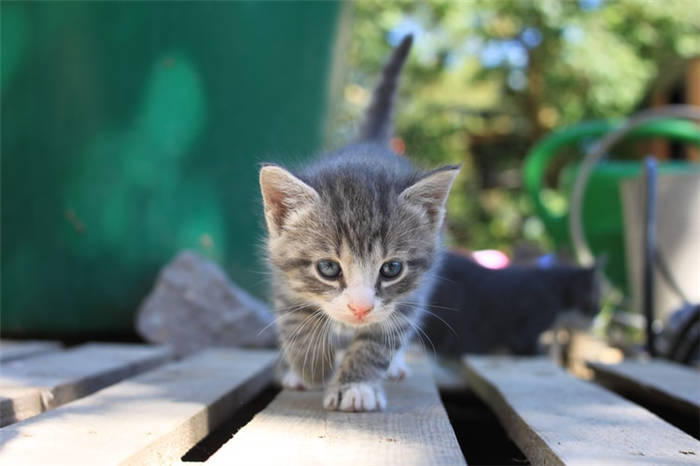
Care after birth
If you took a kitten from the street, the first thing to do is to take it to the vet clinic for examination: the baby may be contagious and sick. It is best to keep it separate from other pets for the first time.
It is easier with domestic kittens. Usually cats find a place for themselves in the apartment or house and arrange a "nest" for their future offspring. Sometimes these are not quite suitable options (on the couch or on the carpet), so choose it yourself.
Suitable A plastic bed with solid walls: on the bottom we recommend putting a mattress and a disposable diaper to protect the fabric. It should be placed where there is no drafts (babies are more prone to get sick than adults), and away from sunlight. You can buy house or soft cot.. They will be comfortable for the family of cats.
During the first 2 months kittens should stay with their mother. Only after that should they be given to other people.
If the kitten is not with her mother, then put a heating pad or any container filled with warm water in the cot. This will give them a sense of security and keep them warm.
Don't try to give the kittens to another cat that has calved: she might reject them or even throw them out of the "nest".
Attention! Babies are very sensitive to the temperature of the environment. You should keep it at 25-31 degrees. If it falls below 21 degrees, then replace the heating pad with a warmer or put another. Buy a thermometer to keep track of the temperature.
If you feel that the kitten is getting cold, take him in your arms, wrap him in a warm cloth and hold him in your arms. You can also give him a 5-10% glucose solution from a bottle, since the increase in blood sugar contributes to an increase in body temperature.
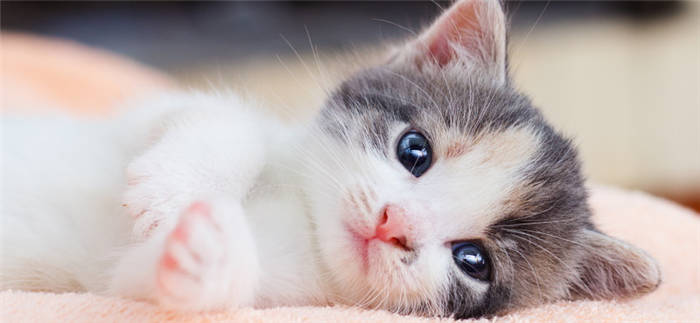
With what and how to feed the kitten
It is best to feed kittens with a special formula. It is not a complete food, but a kind of cat's milk substitute: it has all the necessary ingredients for the harmonious development of the new body.
Important: Do not give newborn kittens cow's or goat's milk. It is not suitable for their nutrition.
To feed kittens, do not use pipettes or spoons. This way you will only hurt them, because the mixture can accidentally get into the upper airways. It's better to buy bottles or nipples with an elongated thin end like a cat's nipple.
Over time, the hole in the end of the bottle will get bigger from constant use. If it gets too big, it is best to replace the nipple with a different one.
You can also use a syringe, but check the piston: if it is too tight, the mixture can shoot down your throat.
The mixture itself should be diluted according to the instructions on the package. Watch its temperature: it should be neither too hot nor too cold.
Warm the mixture in a water bath. You can check its temperature by putting a drop on your wrist. In no case do not warm it in the microwave: it may heat unevenly, and kittens will get a burn of the mucous membranes as a result.
Before diluting the powder, sterilize the bottles. You can use a baby sterilizer, sterilization tablets, or regular boiling water. This is necessary so that the kitten does not pick up any disease through the nipple.
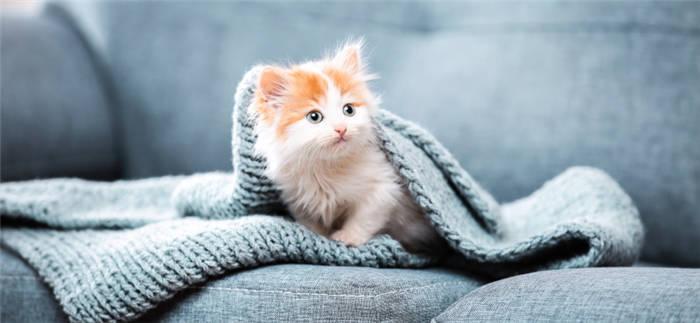
While feeding, it is better to hold the kitten at an angle of about 45 degrees. Usually he stops sucking the pacifier when he is full. The amount of formula you need should be based on the age and weight of the baby. Don't rush him: let him eat at his own pace. If the milk got into the nose, quickly pump it out with a syringe without a needle or an eyedropper. It is very important to keep the feeding frequency:
😼How to feed a small kitten without a mom cat
It is sad when a kitten a few days old (or even from birth) is left without her mother. There are different reasons for this, but this is a topic for a separate article. It is a fact that the owner needs to somehow feed the baby. And of course, to do it correctly.
Your pets are in this situation, and you are completely confused? Do not worry, you will cope – at least everyone who has promised himself to feed the baby, it is quite possible.
No special skills are required, in addition, the nursing period takes only four weeks. Follow all the rules described in this article, be careful and cautious.
Prepare for inconveniences: you will not be allowed to leave the house for more than a couple of hours and not be able to sleep properly. But this is temporary.
This isn't a problem nowadays, with special kitten-feeding mixes, convenient bottles and pacifiers available. Of course, it is highly recommended to buy all this as soon as possible (sold in pet stores), this is better for the kitten and you – you won't have to prepare baby food several times a day.
However, the mixture and utensils for feeding kittens is not always available immediately: in small towns they are not often on sale (due to lack of demand), at night or on total holidays stores are not open.
Yes, and leave the baby one simply can not – ask someone to go to the pet store, or order delivery. That's how it turns out that the first feeding often spend improvised means.
It is best to use baby formula, which you can buy at your local drugstore.
If you can not buy it, thoroughly mix boiled milk (1 cup), raw egg yolk and a few milliliters of vegetable oil.
A newborn kitten will eat no more than 40 ml. Store the food in the refrigerator, but no more than one day.
Watch the food temperature: first week: about +38, second week gradually decrease to +32. 33, on the third week: +27. 28, on the fourth week: about +25.






